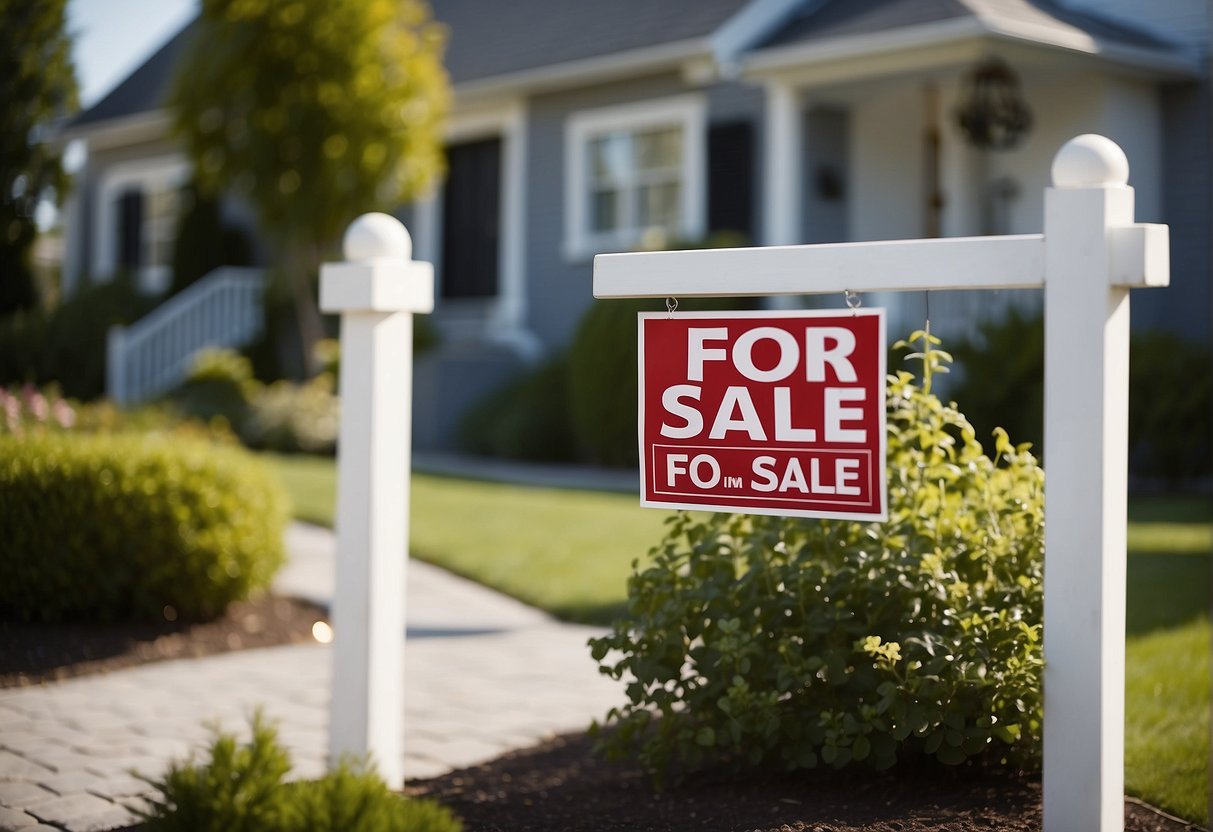
Pricing Your Home for Sale: Expert Strategies for Top Dollar Results
Deciding on the ideal price for your home is a significant factor in a successful sale, as it strongly influences potential buyers’ interest and the eventual closing deal. Pricing a property too high might deter prospective buyers, while underpricing may invite loss of a fair profit margin. As a homeowner, it is crucial to develop a well-planned pricing strategy to attract serious buyers and maximize returns.
Before setting a price for your home, understanding the dynamics of the real estate market is essential. This includes analyzing past trends, future projections, and the current supply and demand for properties in the area. In addition, consulting with a reputable real estate agent can provide valuable insight into pricing, negotiation tactics, and the potential risks and rewards associated with your chosen pricing approach.
Marketing your property effectively also plays a significant role in attracting potential buyers and enabling a smooth sale. This typically involves professional photography, staging, listing on multiple platforms, and organizing showings. When an interested buyer makes an offer, it is crucial to be well-prepared for negotiation processes to ensure a successful closing without compromising your sales goals.
Key Takeaways from Pricing Your Home For Sale
- Developing a well-planned pricing strategy is crucial for attracting serious buyers and maximizing returns.
- Understanding the real estate market dynamics and consulting with an agent can help set the right price.
- Effective marketing, negotiation tactics, and preparedness for closing processes contribute to a successful sale.
Understanding the Real Estate Market
Local Market Dynamics
The local market plays a crucial role in determining the value of a property. Various factors contribute to the local market dynamics, including employment rates, population growth, and infrastructure developments. As a homeowner, it is essential to research and understand the trends in your area to set a competitive price for your property.
Some local factors to consider are:
- Demographics: Age, income, and family composition of the local population can influence property preferences and purchasing power.
- Economic Indicators: Employment rates, wage growth, and business relocation patterns can affect the overall health of the local market.
- Infrastructure Developments: New roads, schools, and other amenities can impact property prices positively or negatively.
Supply and Demand Factors
A key element in understanding the real estate market is recognizing the supply and demand factors within your local market. These factors can fluctuate over time, which impacts the overall market conditions.
A neutral market is a balanced situation where the supply of available properties meets the demand from buyers, leading to stable home prices. Here are the three possible scenarios you may encounter:
- Buyer’s Market: A higher supply of properties than demand, leading to lower prices. Buyers have the upper hand due to a variety of choices and room for price negotiations.
- Seller’s Market: A higher demand for properties than supply, causing an increase in prices. In this situation, sellers have the advantage because of limited inventory and multiple buyers competing for the same property.
- Neutral Market: An equilibrium between supply and demand with stable prices. Neither buyers nor sellers have a significant advantage in the market.
To determine the supply and demand factors in your local market, analyze the following metrics:
- Inventory Levels: The number of properties listed for sale in your area. A low inventory might indicate a seller’s market, while a high inventory may suggest a buyer’s market.
- Days on Market (DOM): The time a property typically takes to sell. Properties selling quickly may indicate high demand, while slower sales may reveal lower demand or oversupply of homes.
Overall, understanding the real estate market, local dynamics, and supply and demand factors can help you accurately price your home for sale, ensuring a smooth and successful transaction.
Setting the Right Price
When pricing your home for sale, it’s crucial to set the right price to attract potential buyers and maximize your profit. This section will discuss Comparative Market Analysis, Pricing Strategies, and Potential Buyer Appeal to guide you in determining the best list price for your property.
Comparative Market Analysis
A Comparative Market Analysis (CMA) is a report that compares your home to similar homes, or “comps,” in the area. It takes into account various factors like the size, age, condition, and features of comparable homes that have recently sold or are currently on the market. To perform a thorough CMA, consider the following components:
- Location: As the old saying goes, “location, location, location” is vital. Focus on comparable homes within your specific neighborhood or a close radius.
- Size: Examine homes with similar square footage and the number of bedrooms and bathrooms for an accurate comparison.
- Features and upgrades: Compare the quality and updates of your home to other comparable properties – such as modern kitchens and bathrooms, outdoor living spaces, or energy-efficient modifications.
Completing a comprehensive CMA can help you price your home to better align with the current market and stay competitive.
Pricing Strategies
Several pricing strategies can help you find the sweet spot for your list price. Here are some common methods to consider:
- Market Value Pricing: Based on your CMA, set a price that accurately reflects the value of similar homes in the area.
- Slightly Below Market Value: Listing your home at a price slightly below its market value can create a sense of urgency and drive multiple offers, potentially resulting in a higher final sale price.
- Psychological Pricing: Consider using the proven strategy of pricing your home at a rounded number that ends in 900 or 990 (e.g., $299,900). This approach can make your list price appear more favorable to buyers.
Remember, it’s essential to keep an eye on comps and be ready to adjust the price if necessary, based on market changes or buyer feedback.
Potential Buyer Appeal
To attract the widest range of potential buyers to your property, consider the following:
- Staging: Properly staging your home allows buyers to envision themselves living in the space. Declutter, depersonalize, and highlight your home’s best features.
- Professional photography and marketing: High-quality photos and effective marketing can have a significant impact on your home’s online presence and potential buyer interest.
Setting the right price for your home, conducting a thorough CMA, and implementing effective pricing strategies and marketing techniques will increase your home’s desirability and potential buyer appeal, ultimately leading to a successful sale.
The Role of Home Valuation

Professional Appraisals
An accurate valuation is essential when pricing your home for sale. A professional appraisal conducted by a licensed and certified appraiser is one method that can be utilized. The appraiser will assess your property, taking into consideration its location, size, condition, and unique features. They will also analyze the current market and comparable homes in your neighborhood to determine an appropriate value.
It’s important to note that an appraisal is an unbiased, third-party evaluation conducted by a professional who is knowledgeable and abides by industry standards. Real estate agents who offer their opinion on a home’s worth should not be confused with professional appraisers. A certified appraiser will provide a detailed report, giving the seller a solid foundation for pricing their home.
Online Estimation Tools
Another popular method for home valuation is using online estimation tools, such as Zillow’s Zestimate. These tools are designed to provide an estimate of your home’s value using algorithms and available data. Some of the factors that can influence these estimates include:
- Location
- Property size
- Number of bedrooms and bathrooms
- Comparable recent sales
While online estimation tools can provide a starting point for assessing your home’s value, it’s essential to approach these estimates with caution. The accuracy of these tools can vary, and they may not always account for your property’s unique features or any recent upgrades. It’s recommended to consult with an experienced real estate agent or professional appraiser for a more accurate and reliable valuation.
In conclusion, home valuation plays a crucial role when pricing your home for sale, and using both professional appraisals and online estimation tools can help you make an informed decision. Ultimately, it’s essential to seek professional advice to ensure accuracy and maximize your chances of selling your home at the best possible price.
Marketing Your Home

Listing and Presentation
When it comes to marketing your home, the first step is creating an enticing listing. This involves crafting a clear and concise description of the property, highlighting its most appealing features. It is essential to include details like the number of bedrooms, bathrooms, square footage, and any recent updates or renovations.
A well-structured listing should include:
- Property type: Single-family home, condo, townhouse, etc.
- Location details: Neighborhood, nearby amenities, and accessibility
- Home features: Age of the house, layout, and any unique aspects
Digital Accessibility
In today’s digital age, online visibility is critical in marketing your home effectively. With potential buyers often beginning their home search online, make sure your listing is easily accessible across various platforms and websites.
To optimize digital accessibility, consider:
- Posting your listing on popular real estate websites
- Sharing the listing on social media platforms
- Using search engine optimization (SEO) techniques to increase visibility
Staging and Photography
Staging plays an essential role in marketing your home. A well-staged home can make a world of difference in capturing a potential buyer’s attention and imagination. This involves decluttering, depersonalizing, and arranging the furniture to create a warm and inviting atmosphere.
Here are some tips for successful staging:
- Remove clutter and personal items
- Clean and freshen up the space
- Use neutral colors and simple decor
High-quality photography is equally important when marketing your home. Professionally taken photos that highlight your home’s best features are an essential aspect of online presentations. It is recommended to hire a professional photographer, as they have the skills and equipment necessary to produce outstanding images.
In summary, effectively marketing your home is an essential aspect of the selling process. By creating an engaging listing, ensuring digital accessibility, and investing in staging and photography, you increase the chances of attracting potential buyers and achieving a successful sale.
Negotiating Offers and Closing

Handling Multiple Offers
When pricing your home for sale, it’s possible to receive multiple offers from interested buyers. As the seller, it’s important to carefully evaluate each offer and determine which one best aligns with your goals. Consider the following factors when comparing offers:
- Purchase price: While the highest price is often most attractive, other factors might make a lower-priced offer more appealing.
- Financing: Buyers with a pre-approved mortgage may have a better chance of closing without delays.
- Contingencies: Offers with fewer contingencies, such as inspections or appraisals, can lead to a smoother transaction.
In a bidding war scenario, it’s important to be transparent and fair to all parties. One strategy is to set a deadline for all offers and inform all potential buyers, allowing them to present their best offer. Once the deadline has passed, evaluate each offer objectively and make the best decision for your situation.
Understanding Closing Costs
Closing costs are expenses and fees associated with finalizing the sale of your home. Both buyers and sellers can be responsible for covering different portions of these costs. Some common closing costs include:
- Loan origination fees: charged by the lender to the buyer for processing their mortgage application
- Appraisal fees: paid by the buyer to determine the fair market value of the property
- Title search and insurance fees: ensure the property has a clear and legal title, typically paid by the buyer
- Escrow fees: charged by the escrow company to manage the transfer of funds and documents between parties, often split between the buyer and seller
It’s important to be aware of the closing costs you’ll be responsible for as a seller. Although they vary depending on the specifics of the transaction, on average, sellers can expect to pay between 2% and 5% of the sale price in closing costs. Consider negotiating your closing costs with the buyer to reach a fair and mutually beneficial agreement.
Legal and Ethical Considerations
Disclosure Requirements
When pricing your home for sale, it is important to be aware of the disclosure requirements set forth by regulatory authorities like CREA and Realtor. Sellers have a legal obligation to disclose any known material defects or issues with the property, such as structural damage, mold, or pest infestations, to potential buyers. Failure to disclose these issues can lead to legal ramifications.
Real estate agents should provide guidance on the necessary information to include in the disclosure statement. This may include:
- Structural Issues
- Plumbing or electrical problems
- Environmental hazards
- Pest infestations
Maintaining transparency and honesty throughout the home pricing process will not only protect sellers legally but also establish trust with potential buyers.
Fair Housing Laws
Another crucial aspect of pricing your home for sale is adhering to fair housing laws. In many places, laws like the Equal Housing Opportunity act prohibit discrimination against buyers based on race, color, religion, national origin, gender, disability, or familial status. It’s vital that sellers and the real estate agents representing them remain neutral and focused on the property’s attributes while setting a price.
To ensure compliance with fair housing laws, consider the following practices:
- Avoid Bias: Utilize objective data and relevant comparables when determining the home’s price.
- Market Equitably: Ensure that marketing materials appeal to a diverse range of buyers, avoiding any language or imagery that could be seen as discriminatory.
- Stay Informed: Regularly review updates to fair housing laws and any potential regulatory changes.
By following these principles, sellers and their agents can ensure a legally compliant and ethical home pricing and selling process.
Preparing for Sale
When preparing your home for sale, it’s essential to take the necessary steps to ensure it stands out to potential buyers. Two crucial aspects to consider are home improvements and repairs and preparing documentation and disclosures. By addressing these aspects, you increase the likelihood of attracting serious buyers and getting a better sale price for your property.
Home Improvements and Repairs
Before putting your home on the market, it’s essential to address any issues that may deter potential buyers. Evaluate the condition of your property and identify areas that require repairs, upgrades, or general maintenance. Some common items to consider include:
- Roof repair or replacement
- Upgrading outdated appliances
- Repainting walls and ceilings
- Replacing worn carpet or flooring
- Landscaping and external maintenance
Keep in mind that not all improvements will provide a high return on investment. It’s crucial to prioritize projects that will boost your home’s overall appeal while staying within your budget.
Documentation and Disclosures
To ensure a smooth and hassle-free sale, it’s essential to gather all necessary documents and prepare accurate disclosures. Some vital documents include:
- Proof of ownership (deeds, mortgage statements, etc.)
- Property tax records
- Homeowners association (HOA) documents (if applicable)
- Copies of permits/licenses for home improvements
- Home warranty (if applicable)
Additionally, many states require sellers to provide a written disclosure of any known defects or issues affecting the property. These disclosures typically cover items such as structural problems, environmental hazards, or issues with systems like plumbing, electrical, and HVAC. Being upfront with potential buyers can help avoid any legal issues and demonstrates transparency in the selling process.
In conclusion, investing time and effort in preparing your home for sale by making necessary improvements and repairs, as well as gathering essential documentation and creating accurate disclosures, can go a long way in ensuring a successful and profitable transaction.
Post-Sale Considerations
Calculating Net Proceeds
When selling your home, it is important to calculate the net proceeds you will receive after the sale. This is the final amount of money you can expect to receive after subtracting all costs from the gross sales price.
Here is a brief example of how to calculate net proceeds:
- Determine the gross sales price – This is the final agreed-upon price during the negotiation process.
- Subtract the costs – This includes agent commissions, closing costs, and any other fees that may apply to the sale.
- Calculate the net proceeds – This is the remaining sum after subtracting the costs from the gross sales price.
When calculating net proceeds, consider the following:
- Escrow fees – This is the fee charged by the escrow company for their services in facilitating the transaction.
- Agent commissions – This is typically 5-6% of the gross sales price and is split between the buyer’s agent and the seller’s agent.
- Closing costs – These are additional costs that a seller may incur as part of the transaction. Examples include title insurance, termite inspections, and transfer taxes.
Net Proceeds Calculation Example:
Gross Sales Price: $500,000
Agent Commissions (6%): $30,000
Escrow Fees: $2,000
Closing Costs: $5,000
Net Proceeds = $500,000 - $30,000 - $2,000 - $5,000 = $463,000
Post-Sale Responsibilities
After the sale of your home, there are several post-sale responsibilities to consider in order to ensure a seamless transition for both parties. These responsibilities may include:
Notifying utility companies – Notify your utility providers (water, gas, electricity) of the date of the sale to transfer or cancel services accordingly.
Address change – Update your mailing address with the post office, government agencies, banks, and any other relevant entities.
Finalizing tax documentation – You may need to consult with your tax advisor to finalize and complete tax documents related to the sale of your home.
Scheduling a move-out date – Coordinate with the buyer to determine an appropriate move-out date that works for both parties. This might include renting temporary storage if needed.
Remember, keeping track of your post-sale responsibilities will help to ensure a smooth and efficient process for both you and the buyer.
Luxury Specialist at McGraw Realtors
With a diverse background, including a career as an Air Force fighter pilot and entrepreneurship, Bill transitioned to real estate in 1995. Co-founding Paradigm Realty with his wife, Charlene, he quickly rose to prominence in Oklahoma City’s luxury real estate scene. Now, as one of the top agents with annual sales surpassing $20 million, Bill’s dedication to exceptional service remains unparalleled. With a legacy spanning over two decades in the industry, Bill’s expertise and commitment make him a trusted name in luxury real estate.